ORION HF TRANSCEIVER
UPDATED March 1, 2005
The Ten-Tec ORION represents an entirely new concept in high-performance HF transceivers. Our goal with this new groundbreaking design is to deliver the finest performance level to date from an amateur transceiver.
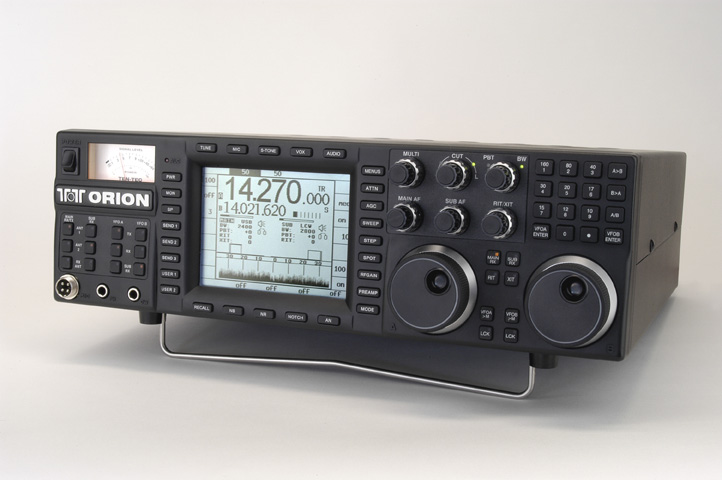
Take a look at ORION's primary benefits:
The heart of the ORION design is a pair of 32-bit floating-point ADI SHARC DSP processors. Using dual 32-bit devices provides much more processing "horsepower" than a transceiver using a single 32-bit DSP processor can provide. The result? Absolutely unparalleled HF receiver performance, filtering, and flexibility.
Full dual receive capability. An amateur-bands-only main receiver, (10 through 160 meters) utilizes both crystal and IF-DSP filtering. The sub receiver is IF-DSP and is general coverage from 100 kHz to 30 MHz. Both receivers can be used simultaneously on any frequency, with no compromise in performance. The two receivers can share a single antenna or each can be fed to a separate antenna. Receiver controls are available on both receivers. Bandwidth, AGC, PBT, Hi-Lo Cut, AF and RF Gain, attenuator, DSP NR and notch filtering are all selectable independently on each receiver.
Very high RX intercept points, superior dynamic range and an extremely low phase-noise synthesizer make ORION's main receiver performance unmatched by any other HF transceiver.
590 receive IF-DSP bandwidth filters independently selectable on each of the main and sub receivers (100 Hz - 6000 Hz in 10 Hz steps). The main receiver also accomodates up to six crystal filters in the first I-F stage. Three of the six filters at 6.0, 2.4, and 1 kHz are standard. Optional filters for 1.8 kHz, 500 Hz, and 250 Hz can be added. These filters can be cascaded with any of the 590 selectable IF-DSP filters. The sub receiver has its own set of 590 filters that are selectable independent of the main receiver filtering. Rather than being limited to a single wide roofing filter at 15 or 20 kHz (compromising close-in receiver performance), ORION's selectable crystal filters narrow the roofing bandwidth to as little as 250 Hz to avoid any compromise of close-in receiver performance caused by loud nearby signals. No other transceiver does this.
Programmable AGC response time for both receivers.. Conventional AGC settings of OFF, FAST, MED, and SLOW are provided, but the new programmable mode is groundbreaking. Users may build their own personal AGC characteristic by selecting threshold, hang and decay rates. More than one million possible AGC combinations can be selected in programmable AGC mode. Favorite programmed AGC settings can also be saved and instantly recalled by the operator. Each receiver can have its own AGC settings selected regardless of where the other receivers AGC setting is placed.
True diversity reception using both receivers. Both receivers can be simultaneously fed to two separate antennas on the same frequency and controlled using a single VFO tuning knob. Superior low-band DXing capability using two separate receive antennas, on two receivers, and transmitting on a third TX antenna. Three antenna connections are provided: Two SO-239 connectors for transceive or receive antennas, a third via phono connector for RX-only use.
Continuous real-time spectrum display allows monitoring of band activity. Selectable sweep ranges allow user-definable limits to the amount of spectrum being monitored with ORION main receiver.
"Instant Two Radio Mode" allows ORION to instantly QSY between two different bands. Two linear amplifiers, two sets of accessory devices via dual band data outputs and two antennas can optionally be connected to ORION to allow instantaneous QSY (useful for seeking out and working stations on one band during a contest between CQing on a different band, for example).
Virtually indestructable 100-watt PA. Over-voltage protection, current protection for final transistors and thermal shutdown are built-in. Rated 100% duty cycle, 100 watts output, no time limit with added optional model 310 cooling fan.
Superb SSB audio is yours at a touch of the AUDIO button. Audio equalization is provided in both transmit and receive. The transmit response can be adjusted to have more bass or more treble. Separately, receiver audio can be EQed for bass and treble response. 18 selectable SSB transmit bandwidths to a maximum of 3.9 kHz are provided. See figures 3, 4, and 5 below for TX and RX equalizer graphs.
Ten-Tec's new Panoramic Stereo receive feature. Listening with stereo headphones, you can turn PS receive on and hear signals in stereo. As you tune across the band, signals move from one side through center to the other side in your headphones. Better than so-called "binaural" reception, this unique Ten-Tec feature can be used in SSB modes as well as CW. You've got to hear it to believe it! See below for downloads of example .WAV files.
Adjustable rise and decay times for transmitted CW waveform. User adjustable at the touch of a knob from 3 to 10 mS in 1 mS steps for "hard" or "soft" keying according to your taste.
Nine adaptive DSP noise reduction filters let you select the right amount of NR for elimination of broadband hiss, noise, etc., plus DSP automatic notch for auto filtering of interfering carriers in SSB modes. Manual notch filter is also provided with greater than 60 dB of cut and with adjustable width.
Dual noise blankers. Both a traditional-style analog and an IF-DSP noise blanker are provided for suppression of line and other pulse-type EMI.
Heavy duty internal automatic antenna tuner (optional). Ten-Tec's internal auto tuner is no mere load trimmer - from 6 to 800 ohms may be matched (10:1 nominal SWR). Coax fed antennas only.
Voice keyer and CW memory keyer built-in. Program up to three voice messages and up to three CW messages for playback by pressing the SEND1, SEND2, and SEND3 buttons.
"60 METER READY"- the ORION is ready to operate on the new 5 MHz allocation.
"Panic" on-the-fly reset button. Managed to get yourself confused by pushing buttons and turning knobs? Press and hold the RECALL button and the radio resets parameters to factory defaults without changing the mode or frequency of operation or having to turn off the transceiver.
Ten-Tec was first with Flash-ROM update capability with our Pegasus transceiver back in 1998. ORION is also Flash-ROM updatable. To obtain the latest version of the ORION, simply visit our firmware download website at www.rfsquared.com and download the software. Connect ORION to your computer via a serial port cable, and send the software to the radio. It's that easy!
MORE INFORMATION ON ORION IS ALSO AVAILABLE:
Click here for pictures and screen shots of ORION.
Click here (if you are an ARRL member) to read the January 2004 QST Product Review of the ORION. The ARRL review states that the ORION has the best close-in receiver performance of ANY transceiver they have measured, best low noise synthesizer phase noise performance ever measured, best suppression of unwanted keying sidebands (key clicks, et al, on CW) ever measured among other "bests" noted.
Click here to read the presentation on receiver performance given by receiver guru Rob Sherwood at the 2004 Dayton Hamvention, along with a receiver performance table representing 74 different transceivers. ORION ranks #1 of all receivers tested by Sherwood for close-in dynamic range.
Click here to visit the receiver performance table compiled from measurements done by Tom Rauch, W8JI of DX Engineering.
Click here to read the Jan/Feb 2004 National Contest Journal long review of the ORION written by noted DXer, UBA Belgian amateur radio society president and author of the definitive work on weak signal DX operation, "Low Band DXing", John Devoldere, ON4UN.
Click here to read the side-by-side on-air test report from Germany by Bavarian Contest Club president DL8OH and BCC member DJ0IP. DL8OH's new ORION and other manufacturer's transceivers are tested A/B together. Posted on the BCC website. Written by DJ0IP (in English).
Click here to read the review of the ORION published in the January 2004 issue of the German amateur magazine Funk Amateur. This document is in .pdf format, in German.
Click here to read the "Optimal uses for ORION receiver for weak-signal DXing and contesting" document by W4PA and KF6DX.
Click here to read the detailed technical explanation of the design of ORION, written by Doug Smith, KF6DX
Click here for the thorough technical explanation of the programmable digital AGC system utilized in ORION.
Click here to read the article on CW transmit occupied bandwidth and how the ORION's adjustable rise/fall time and "textbook" CW waveform helps eliminate annoying TX key clicks.
Model 565 ORION Technical Specifications - claimed specifications are from actual measurements of production ORION units done by the Ten-Tec engineering staff.
Unless noted, all measurements and specifications below done at 3.5 MHz
GENERAL:
Frequency range: 500 kHz-30 MHz sub RX; 1.8-2.0, 3.5-4.0, 5.25-5.40 (when allocated), 7.0-7.3, 10.1-10.15, 14.0-14.35, 18.068-18.168, 21.0-21.45, 24.89-24.99, 28.0-29.7 TX and main RX; � 10 kHz additional for MARS operation.
Tuning Step Size: Selectable 1, 10, 100, 1k, 10k and 100 kHz
Frequency stability: � 3 ppm. TCXO equipped.
Antenna impedance: 50 ohms nominal.
Antenna connectors: 2x SO-239; 1xRCA female.
Modes: USB, LSB, AM, FM, CWUSB, CWLSB, AFSK; advanced Panoramic Stereo(tm).
IFs: IF1=9 MHz, IF2=450 kHz, IF3=14.0 kHz main; IF1=45 MHz, IF2=450 kHz, IF3=14.0 kHz sub.
Display: 320x240 graphic LCD, transflective, white LED backlight, adjustable brightness and contrast. Reversible for black background, white lettering.
VFOs: Receivers operate on any two bands simultaneously; either VFO may be assigned to transmitter using the A/B system.
Supply voltage: 13.8 Vdc nominal; reverse-polarity and over-voltage protection standard.
Operating temperature range: 0-50� C
Dimensions (HxWxD): 5.25" x 17.0" x 18.75" (13.3 x 43.2 x 47.6 cm)
Weight: approx 20 lbs. (9.2 kg)
Construction: Al chassis, steel cabinet, glass-epoxy printed-circuit boards.
PC control port: EIA-232 standard, DE-9F.THE FOLLOWING SPECIFICATIONS APPLY TO BOTH RECEIVERS:
Digital AGC system: Programmable AGC threshold; programmable hold and decay times, fixed attack. Independently selectable on each receiver.
RX audio equalizer: In addition to passband tuning, bass/treble boost/cut up to 6 dB/octave.
RX audio output power: 2 W into 4 ohms, < 3% THD. (see figure 8 below).
Line-level output: 0 dBm into 600 ohms.
RX notch filter: IF DSP, adjustable width, depth > 50 dB, notch reflected on S-meter; multi-tone auto-notch, adjustable 0-9.
RX noise reduction: IF DSP, adjustable 0-9.MAIN RECEIVER:
SSB sensitivity: <0.18 �V for 10 dB SINAD at 2.4 kHz BW, pre-amp on typical;
<0.5 �V for 10 dB SINAD at 2.4 kHz BW, pre-amp off typical.
AM sensitivity: <1.50 �V for 10 dB SINAD at 6.0 kHz BW, 30% modulation, 1 kHz, pre-amp off.
FM sensitivity: <2.50 �V for 12 dB SINAD at 15 kHz BW, 3-kHz deviation, 1 kHz, pre-amp off.
Selectivity: 590 built-in DSP filters from 100-6000 Hz, SSB, CW; 4 & 6 kHz AM, 15 kHz FM (-3 dB points, typical). Four 9-MHz-IF crystal filters standard, 15 kHz, 6 kHz, 2.4 kHz, 1.0 kHz; three others optional, 1.8 kHz, 500 Hz and 250 Hz.
IP3: +25 dBm typical, 20-kHz spacing at BW=2.4 kHz, pre-amp off; +24 dBm typical, 5-kHz spacing, BW=500 Hz, pre-amp off. (see Figure 1 below).
IMD3 dynamic range: 101 dB typical, pre-amp off, 20-kHz and 5-kHz spacing.
IP2: +75 dBm typical.
LO phase noise: -136 dBc/Hz typical from 0.5-20 kHz. (see Figure 2 below)
Image rejection: >70 dB.
IF rejection: >70 dB.
Other spurious response rejection: >90 dB, dF>1 MHz.
Internal birdies: None stronger than specified sensitivity.
Current drain: 2 A typical, audio reduced.
RIT range: � 10 kHz.
S-meter: S-9=50 �V.
Recovery time: < 20 ms
Noise blankers: Hardware, on/off and software, adjustable 0-9; operate together or separately.
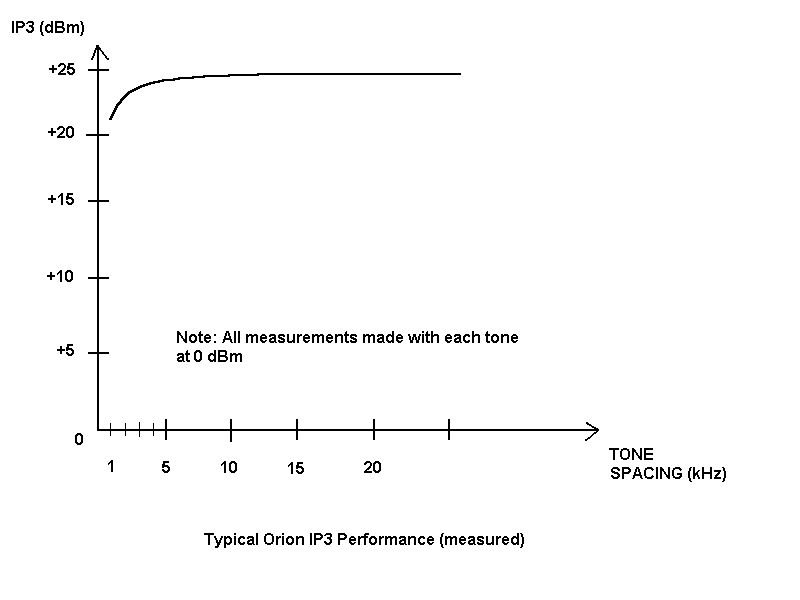
Figure 1. ORION typical third-order intercept performance (measured)
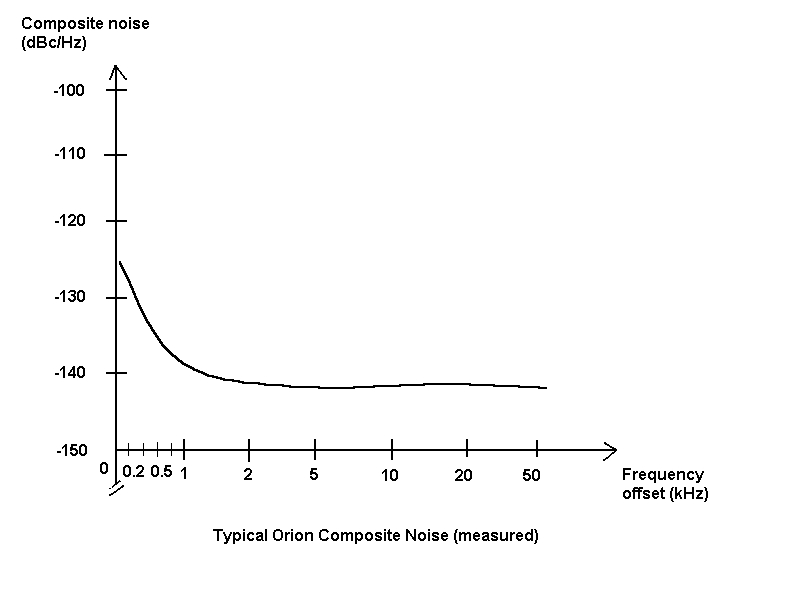
Figure 2. ORION typical LO phase noise graph (measured)
SUB RECEIVER:
Sensitivity: 0.35 �V typical for 10 dB SINAD at 2.4 kHz BW, SSB mode.
Selectivity: 590 filters built in from 100-6000 Hz, SSB, CW; 4&6 kHz AM; 15 kHz FM (-3 dB points, typical).
IP3: +5 dBm typical, 20-kHz spacing.
IP2: +71 dBm typical.
Image rejection: > 70 dB.
IF rejection: > 70 dB.
S-meter: S-9=50 �V
Recovery time: < 20 ms.
Noise blanker: Software, adjustable 0-9.TRANSMITTER:
Power output: Adjustable 5-100 W, � 1 dB, ALC controlled.
Duty cycle: 100% intermittent service; continuous with user-supplied cooling fan.
Microphone input impedance: >10 kohms at 1 kHz.
Microphone sensitivity: 5 mV for full power output; internal gain adjustment; dc available for electrets.
Speech processor: RF compression 0-9.
Line-level input: -6 dBm into 600 ohms for full output.
TX bandwidth: 100-3900 Hz in 10-Hz steps.
TX frequency response: 50-3900 Hz max -6 dB points, adjustable.
TX equalizer: Up to 6 dB/octave bass/treble boost/cut.
TX speech monitor: Audio taken after filtering, processing.
SSB carrier suppression: > 50 dB.
Unwanted sideband suppression: > 60 dB at 1 kHz.
Harmonic and spurious outputs: > 50 dB below 100 W; > 40 dB below 5 W.
T/R switching: PTT or VOX on SSB, AM, FM, AFSK; adjustable QSK on CW; adjustable rise and fall times on CW 3-10 ms;
CW keyer speed range: 5-50 wpm; adjustable weighting.
CW offset: Programmable 300-1000 Hz in 10 Hz steps. Sidetone pitch automatically matches selected offset.
XIT range: � 10 kHz
FM deviation: � 5 kHz peak nominal.
Current drain: 25 A max.Figures 3, 4, and 5 below are equalizer curves.
These figures show amplitude vs. frequency; that is, the frequency response. The curves apply to both receiver equalizers and the transmitter equalizer. The figure at the top is the 0-dB or flat setting. The second curve is the �20-dB curve; the third is the +20-dB curve.
The setting of the equalizers refers to the amplitude in dB at about 100 Hz relative to the highest frequency in the passband. For example, the �20-dB setting shows �20 dB at 100 Hz relative to 0 dB at 6 kHz.
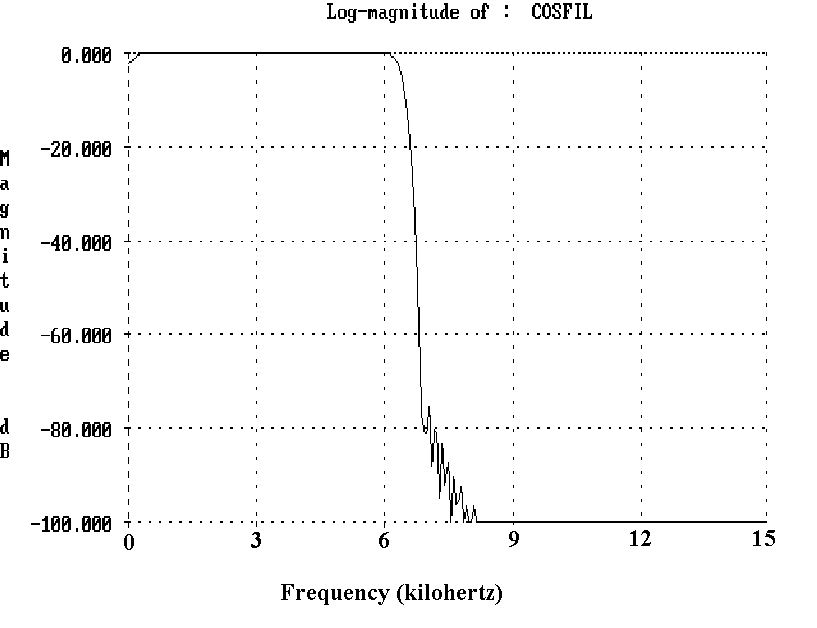
Figure 3. Flat response.
Figure 4. -20 dB response
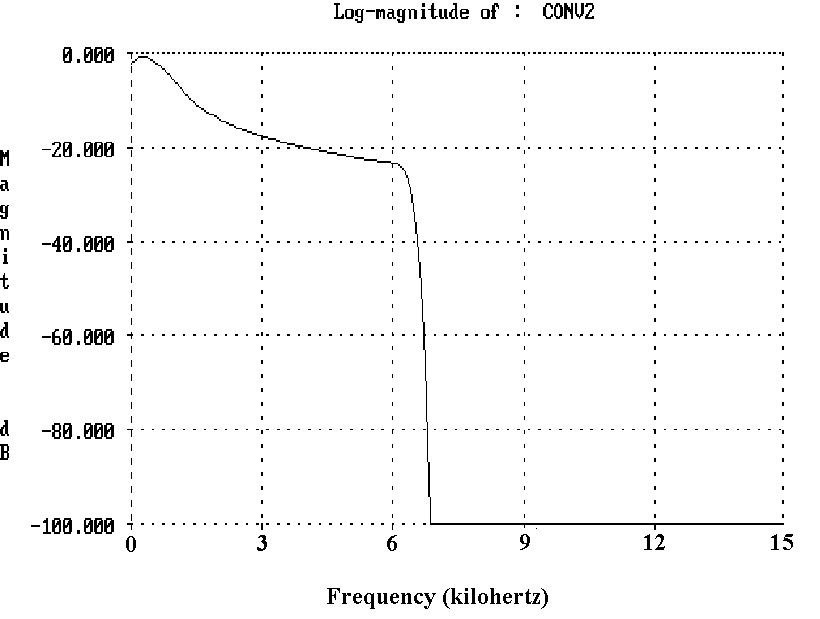
Figure 5. +20 dB response.
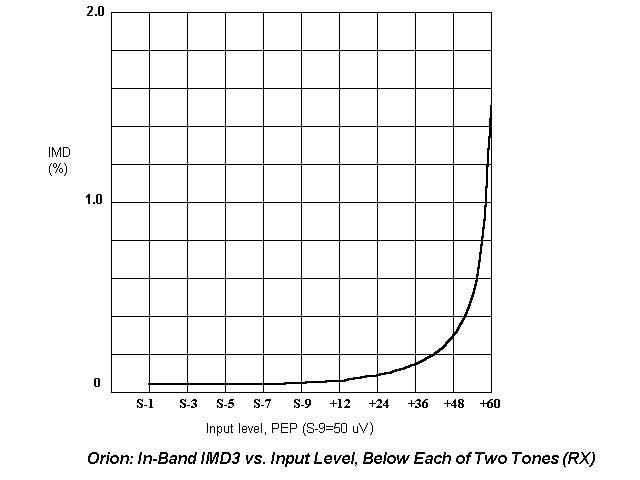
Figure 6.
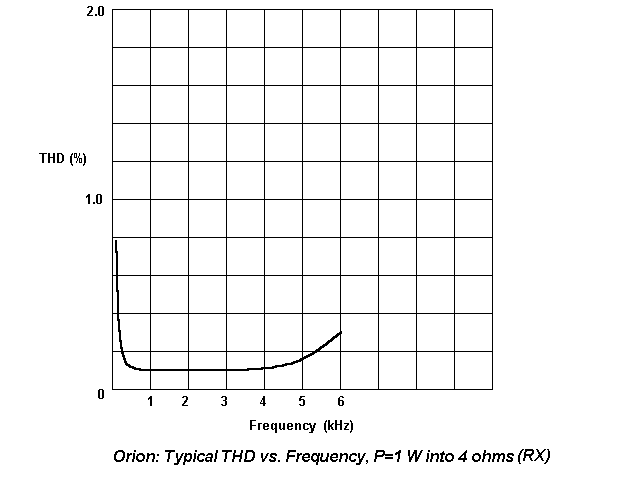
Figure 7.
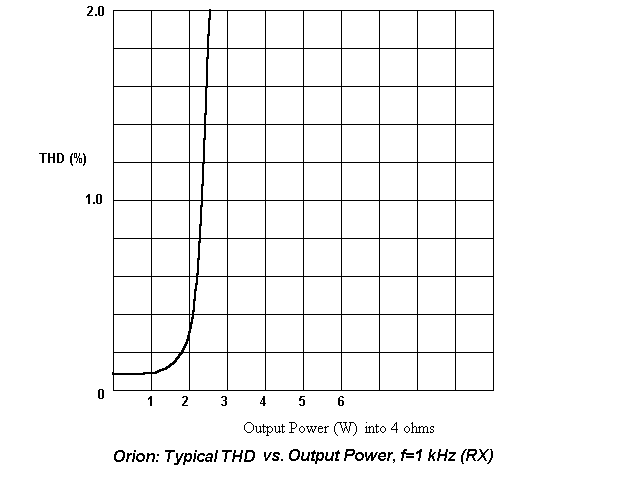
Figure 8.
All specifications subject to change without notice.
| Description: | Cost: |
| 565 Orion HF Transceiver | $3300.00 |
| 565AT Orion HF Transceiver with internal autotuner | $3599.00 |
| Model 217 - 500 Hz, 8 pole ladder CW filter | $ 109.00 |
| Model 218 - 1.8 kHz, 8 pole SSB filter | $ 109.00 |
| Model 219 - 250 Hz, 6 pole CW filter | $ 109.00 |
| Model 963 - switching power supply for Ten-Tec HF transceivers. 115/230 VAC input, 25 amps continuous duty at 13.8 Vdc output. Screw down terminals on rear for attachment of transceiver power cable. Size: HWD 3.75" x 7" x 9.25". Weight, 4 pounds. | $ 169.00 |
| Model 701 - Hand microphone, electret condenser with coiled cord and 4-pin connector. | $ 28.00 |
| Model 706 - Desk microphone, electret condenser with coiled cord and 4-pin connector. | $ 99.95 |
| Model 302R, Remote encoder/ keypad. | $ 139.00 |
| Model 307B - External speaker. | $ 98.00 |
| Model 310 - Cooling fan assembly. | $ 39.95 |
| Model 311- Band data converter for use with discontinued models 253 or 420. | $ 79.00 |